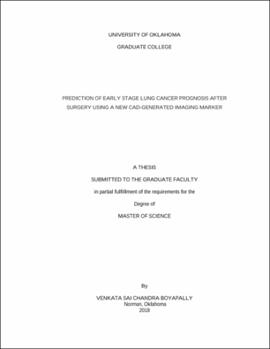| dc.contributor.advisor | Zheng, Bin | |
| dc.contributor.author | BOYAPALLY, Venkata Sai Chandra | |
| dc.date.accessioned | 2018-05-11T15:38:58Z | |
| dc.date.available | 2018-05-11T15:38:58Z | |
| dc.date.issued | 2018-05-11 | |
| dc.identifier.uri | https://hdl.handle.net/11244/299889 | |
| dc.description.abstract | Due to cancer heterogeneity, identifying new clinical markers to more effectively predict prognosis of cancer patients plays an important role to improve efficacy of cancer treatment. Objective of this study is to develop and test a new quantitative imaging (QI) marker to predict prognosis of early stage non-small cell lung cancer (NSCLC) patients after surgery. For this purpose, this study includes following research tasks or steps. First, a new computer-aided detection (CAD) scheme was developed to automatically segment lung and tumor regions from the chest computed tomography (CT) images of all the slices simultaneously using an adaptive pixel value thresholding and/or region growing method. Next, CAD scheme was used to compute a large number of image features related to tumor shape, size, circularity, density heterogeneity, and lung background tissue patterns. Then, a machine learning approach was applied to build a multi-feature fusion based prediction model, which enables to produce a CAD-generated quantitative image (QI) marker for predicting diseases-free survival (DFS) of the NSCLC patients within 3 years after surgery. In order to achieve more robust result of training and testing the machine learning model, a leave-one-case-out (LOCO) cross-validation method was used. A feature selection process using a correlation-based feature subset evaluator and a synthetic minority oversampling technique (SMOTE) were embedded in LOCO based training process. Finally, prediction performance of the QI marker or prediction model was evaluated using the receiver operating characteristic (ROC) and other statistical data analysis. In summary, the goal of this study is to select more effective image features computed from both segmented lung tumors and emphysema related background regions for producing a new CAD-generated QI marker and demonstrate the feasibility of applying this new QI marker to yield higher performance in predicting prognosis of early stage NSCLC patients | en_US |
| dc.language | en_US | en_US |
| dc.subject | Engineering, Electronics and Electrical. | en_US |
| dc.subject | Image Processing | en_US |
| dc.subject | Lung Cancer | en_US |
| dc.subject | Computer Aided Detection | en_US |
| dc.subject | Predictive model | en_US |
| dc.title | PREDICTION OF EARLY STAGE LUNG CANCER PROGNOSIS AFTER SURGERY USING A NEW CAD-GENERATED IMAGING MARKER | en_US |
| dc.contributor.committeeMember | Qiu, Yuchen | |
| dc.contributor.committeeMember | Cheng, Samuel | |
| dc.date.manuscript | 2018-05-05 | |
| dc.thesis.degree | Master of Science | en_US |
| ou.group | College of Engineering::School of Electrical and Computer Engineering | en_US |
| shareok.nativefileaccess | restricted | en_US |
